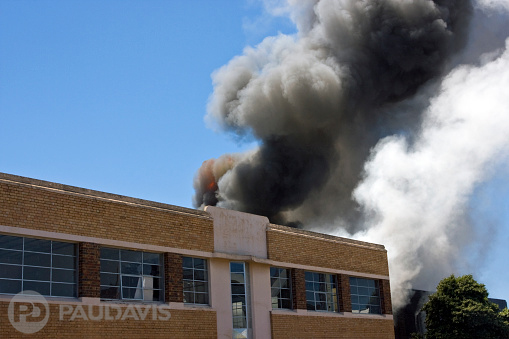
When shocked owners and employees survey the sodden mess after a fire guts their workplace, it’s tempting to immediately don paper masks, sturdy shoes and coveralls to rescue important items. Tempting, but ill-advised: the soot, water and char that have spread throughout the fire scene and across building contents are hazardous to life and limb. The fire has been quenched, but threats to health and safety continue long afterward.
Fueled by modern manufactured materials, today’s fires reach hotter temperatures faster, flashovers occur more quickly, and the resulting smoke and soot is far more toxic. Burn residue from natural materials like wood and cotton are certainly not healthy, but the plastics, nylons, polyurethanes and computer materials found in businesses today can harm human health and the environment far more seriously. When combusted, these newer materials form chemicals like hydrogen cyanide, halogens and formaldehyde that spread across the fire scene and beyond, thanks to the heat, wind and convection of the fire process; chemical risks multiply exponentially if the location contained industrial products. Water applied to fight the flames mixes these chemicals with smoke and soot to create a dangerous slurry that soaks into the structure’s remaining materials and often runs into surrounding areas.
In short, there are excellent reasons why fire departments roll out bright caution tape to cordon off generous perimeters around fire sites: fires leave hazardous conditions that should be entered and handled only by restoration and mitigation specialists like Paul Davis. These professionals have been trained to minimize the substantial human risks to skin, nose, throat, lungs and long-term health that the fire’s residue poses. They know, for instance, that a simple dust mask is insufficiently protective, because soot particles can be as tiny as 2.5 microns in diameter. As they begin recovery work, these specialists implement tested procedures to contain the unsafe residue and prevent further spread into nearby unaffected areas. These experts also use special tools to assess the impact a fire has had on the scene and its contents; even objects that may look pristine – food in closed packages or in refrigerators - may have been exposed to a fire’s byproducts and are unsafe to touch. Professionals will use specially designed products and processes to restore items that can be salvaged.
Finally, these experts know that the toxic slurry of water, soot and chemicals may pose a more immediate threat: soaked walls, floors and ceilings could collapse at any time, trapping unsuspecting but well-intentioned volunteers who dare to quickly grab family photos from a charred desk.
